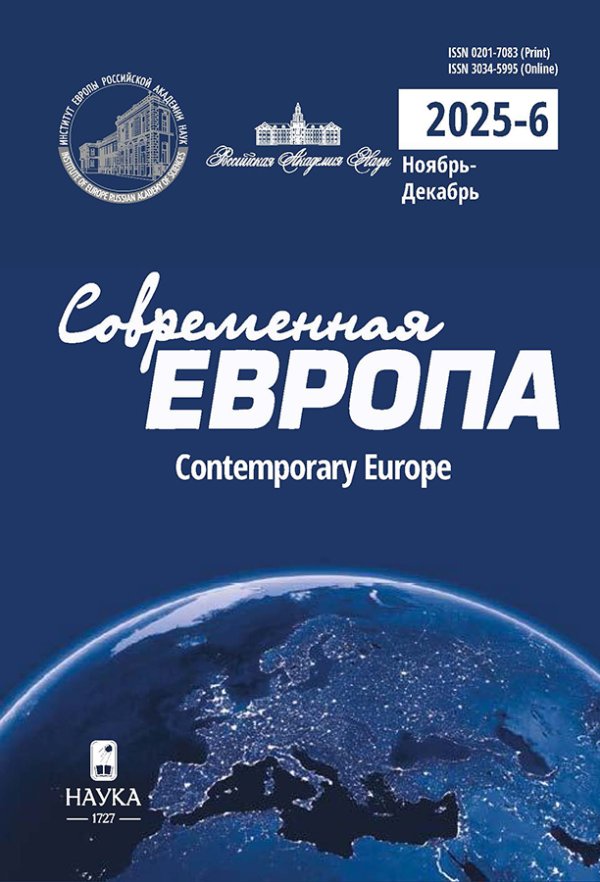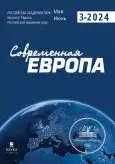How Beneficial is EU Membership for CEE Countries: an Attempt of Critical Analysis
- Authors: Drynochkin A.V1
-
Affiliations:
- Moscow State University of International Relations (MGIMO University)
- Issue: No 3 (124) (2024)
- Pages: 125-137
- Section: Articles
- URL: https://journals.rcsi.science/0201-7083/article/view/260312
- DOI: https://doi.org/10.31857/S0201708324030100
- ID: 260312
Cite item
Full Text
Abstract
About the authors
A. V Drynochkin
Moscow State University of International Relations (MGIMO University)
Email: drinda-hu@yandex.ru
Doctor of Sciences (Economics), Professor Moscow, Russia
References
- Куликова Н.В. (ред.) (2007) Адаптация стран Центральной и Юго-восточной Европы к условиям развития в составе Европейского союза. ИЭ РАН, Москва. 286 с.
- Бучинская О.Н. (2023) Проблемы неравенства и управления в Евросоюзе. Вестник Том ского государственного университета. Экономика. № 62. С. 171–189. doi: 10.17223/19988648/62/12
- Глинкина С.П. (2008) Центральная и Восточная Европа на пути в Евросоюз. Европей ский союз и новые страны-члены: проблемы адаптации. Отв. ред. Куликова Н.В. ИЭ РАН, Москва. С. 15‒48.
- Колобов О.А. (ред.) (2008) Европа: проблемы интеграции и развития. Т. 1. История объединения Европы и теория европейской интеграции. Ч. 1. ФМО/ИСИ ННГУ, Нижний Новгород; Изд-во АГПИ им. А.П. Гайдара, Арзамас. 356 с.
- Кондратьева Н.Б. (2023) Сближение благосостояния стран ЕС в условиях интеграции: проверка гипотезы. Современная Европа. № 7(121). С. 127‒138.
- Мид Дж. (2006) Теория таможенных союзов. Вехи экономической мысли. Том 6. «Меж дународная экономика». Под общ. ред. А.П. Киреева. ТЕИС, Москва. С. 706–717.
- Сергеев Е.А., Воротников В.В. (2023) Стратегия Европейского союза в условиях гло бальной перестройки: автономия или эвтаназия? Издательство «МГИМО-Университет», Москва. 52 с.
- Четверикова А.С. (2020) Страны Вишеградской группы в ЕС: экономические результа ты. Мировая экономика и международные отношения. Т. 64. № 2. С. 63‒70. doi: 10.20542/0131-2227-2020-64-2-63-70.
- Álvarez-Martínez M. T., Polo C. (2017) The short-run effects of EU funds in Spain using a CGE model: The relevance of macro-closures. Journal of Economic Structures. No. 6. doi: 10.1186/s40008-017-0077-8
- Bitzenis A, Andronikidis A. (2006) Cost and benefits of integration in the European Union and in the Economic Monetary Union (EMU). Economics, Management, and Financial Markets Journal. Vol. 1. No. 2. P. 7‒53.
- Bjarnason M. (2010) The political economy of joining the European Union : Iceland's position at the beginning of the 21st century ‒ European Parliament Library. PhD thesis. Vossiuspers Amsterdam University Press, Amsterdam, Netherlands. 281 p.
- Brown D.K., Deardorff A.V., Djankov S., Stern R.M. (1997) An Economic Assessment of the Integration of Czechoslovakia, Hungary and Poland into the European Union. Europe's Economy Looks East: Implications for Germany and the European Union. Ed. by S.W. Black. Cambridge University Press, Cambridge, UK. P. 23‒60.
- Busch B. (2021) Europäische Union. Nicht nur Saldenmechanik. IW-Kurzbericht No. 58. Insti tut der deutschen Wirtschaft, Köln, Germany. 3 p.
- Busch B., Kauder B., Sultan S. (2022) Wer finanziert die EU? Nettozahler und Nettoempfäng er in der EU. IW-Report No. 55. Institut der deutschen Wirtschaft, Köln, Germany. 17 p.
- Christopher J., Anderson M., Shawn R. (2009) Economic Benefits and Support for Member ship in the E.U: A Cross-National Analysis. Journal of Public Policy. Vol. 15. No. 3. P. 231–249.
- Kąkol M. (2015) Theoretical versus Real Benefits of the EU Internal Market. Proceedings ICABR. 14‒18.09. Madrid, Spain. P. 439‒455.
- Keuschnigg C., Keuschnigg M., Kohler W. (2001) The German Perspective on Eastern EU Enlargement. The World Economy. No. 24. P. 513‒542.
- Medve-Bálint G., Šćepanović V. (2020) EU funds, state capacity and the development of transnational industrial policies in Europe’s Eastern periphery. Review of International Political Economy. No. 27. P. 1063–1082.
- Muraközy B, Telegdy Á. (2023) The effects of EU-funded enterprise grants on firms and workers. Journal of Comparative Economics. No. 51. P. 216–34. DOI: https://doi.org/10.1016/j.jce.2022.09.001
- Petrova, B., Sznajder Lee A. (2023) The effect of European integration on economic redistri bution in Central and Eastern Europe. European Union Politics. European Union Politics. Vol. 25. Issue 1. DOI: https://doi.org/10.1177/14651165231210943
- Šostar M, Ristanović V, de Alwis C. (2023) Application of Successful EU Funds Absorption Models to Sustainable Regional Development. Economies. No. 11(9). DOI: https://doi.org/10.3390/economies11090220
- Viner J. (1950) The Customs Union Issue, Carnegie Endowment for International Peace, N.Y., USA.
- Kulikova N. (ed.) (2007) Adaptacia stran Centralnoj I Jugo-Vostochnoj Evropy k usloviam razvitija v sostave Evropejskogo Sojuza [Adoptation of Central and South-Eastern European coun tries to development conditions within the European Union], IE RAS, Moscow, Russia. (In Russian).
- Buchinskja O. (2023) Problemy neravenstva I upravlenija v Evrosojuze [Problems of inequali ty and governance in the European Union], Vestnik Tomskogo gosudarstvennogo universiteta. Economika, 62, pp. 171–189. doi: 10.17223/19988648/62/12 (In Russian).
- Glinkina S. (2008) Centralnaja I Vostochnaja Evropa na puti v Evrosojuz [Central and Eastern Europe on the way to the European Union], in Kulikova N. (ed.) Evropejskij sojuz I novye sstrany chleny: problemy adaptaacij, IE RAS, Moscow, Russia, pp. 15‒48. (In Russian).
- Kolobov O.A. (ed.) (2008) Evropa: problemy integracii i razvitija [Europe: problems of inte gration and development], vol. 1, Istoria objedinenija Evropy I teoria evropejskoj integracii, p. 1, NNGU, Nizhnij Novgorod; AGPI im. А.P. Gajdar, Arzamas. (In Russian).
- Kondratieva N. (2023) Sblizhenie blagosostoyaniya stran ES v usloviyah integracii: proverka gipotezy [Convergence of welfare of EU countries in the context of integration: testing the hypothesis], Sovremennaya Evropa, 7(121), pp. 127‒138. (In Russian).
- Meade J. (2006) Teorija tamoyhennzh sojuyov [The theory of customs unions], in Kireev A.P. (ed.) Vehi ekonomicheskoj mysli. Vol. 6. “Mezhdunarodnaya ekonomika”, ТEIS, Moscow, Russia, pp. 706–717.
- Sergeev Е., Vorotnikov V. (2023) Strategija Evropejskogo sojuza v uslivijah globalnoj pere strojki: avonomija ili evtanazija? [Strategy of the European Union in the context of global restruc turing: autonomy or euthanasia?], MGIMO, Moscow, Russia. (In Russian).
- Chetverikova A. (2020) Strany Vishegradskoj gruppy v EU: ekonomicheskije rezultaty [Vise grad Group countries in the EU: economic results], Mirovaja ekonomika I mezdunarodnye otnosheni ja, 64(2), pp. 63‒70. doi: 10.20542/0131-2227-2020-64-2-63-70 (In Russian).
- Álvarez-Martínez M.T., Polo C. (2017) The short-run effects of EU funds in Spain using a CGE model: The relevance of macro-closures, Economic Structures, 6. doi: 10.1186/s40008-017-0077-8
- Bitzenis A, Andronikidis A., (2006) Cost and benefits of integration in the European Union and in the Economic Monetary Union (EMU), Economics, Management, and Financial Markets Journal, 1(2), pp. 7‒53.
- Bjarnason M. (2010) The political economy of joining the European Union: Iceland's position at the beginning of the 21st century ‒ European Parliament Library, PhD thesis, Vossiuspers Amsterdam University Press, Amsterdam, Netherlands.
- Brown D.K., Deardorff A.V., Djankov S., Stern R.M. (1997) An Economic Assessment of the Integration of Czechoslovakia, Hungary and Poland into the European Union, in Black S.W. (ed.) Europe's Economy Looks East: Implications for Germany and the European Union, Cambridge University Press, Cambridge, UK, pp. 23‒60.
- Busch B. (2021) Europäische Union. Nicht nur Saldenmechanik, IW-Kurzbericht 58, Institut der deutschen Wirtschaft, Köln, Germany.
- Busch B., Kauder B., Sultan S. (2022) Wer finanziert die EU? Nettozahler und Net toempfänger in der EU, IW-Report 55, Institut der deutschen Wirtschaft, Köln, Germany.
- Christopher J., Anderson M., Shawn R. (2009) Economic Benefits and Support for Mem bership in the E.U: A Cross-National Analysis, Journal of Public Policy, 15(3), pp. 231–249.
- Kąkol M. (2015) Theoretical versus Real Benefits of the EU Internal Market, Proceedings ICABR, 14‒18.09, Madrid, Spain, pp. 439‒455.
- Keuschnigg C., Keuschnigg M., Kohler W. (2001) The German Perspective on Eastern EU Enlargement, The World Economy, 24, pp. 513‒542.
- Medve-Bálint G., Šćepanović V. (2020) EU funds, state capacity and the development of transnational industrial policies in Europe’s Eastern periphery, Review of International Polit-ical Economy, 27, pp. 1063–1082.
- Muraközy B, Telegdy Á. (2023) The effects of EU-funded enterprise grants on firms and workers, Journal of Comparative Economics, 51, pp. 216–34. DOI: https://doi.org/10.1016/j.jce.2022.09.001 Petrova B., Sznajder Lee A. (2023) The effect of European integration on economic re distribution in Central and Eastern Europe. European Union Politics, European Union Politics, 25(1). DOI: https://doi.org/10.1177/14651165231210943
- Šostar M, Ristanović V, de Alwis C. (2023) Application of Successful EU Funds Absorption Models to Sustainable Regional Development. Economies, 11(9). DOI: https://doi.org/10.3390/economies11090220
- Viner J. (1950) The Customs Union Issue, Carnegie Endowment for International Peace, N.Y., USA.
Supplementary files










